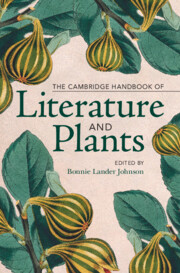Book contents
- The Cambridge Handbook of Literature and Plants
- The Cambridge Handbook of Literature and Plants
- Copyright page
- Contents
- Figures
- Contributors
- Introduction
- Part I Historical Periods
- Part II Anglophone Literary Forms
- Part III Global Regions
- Chapter 12 Plants in the French and Francophone Literary Tradition
- Chapter 13 Early American Plant Writing
- Chapter 14 Plants in the Literatures of Latin America and the Caribbean
- Chapter 15 Plants in the Literatures of Australia
- Chapter 16 Plants in the Literatures of Southern Africa
- Chapter 17 Lotus
- Chapter 18 Plants in the Literatures of India
- Chapter 19 Tree-Rings of Middle Eastern Poetry
- Select Bibliography
- Index
Chapter 12 - Plants in the French and Francophone Literary Tradition
from Part III - Global Regions
Published online by Cambridge University Press: 06 February 2025
- The Cambridge Handbook of Literature and Plants
- The Cambridge Handbook of Literature and Plants
- Copyright page
- Contents
- Figures
- Contributors
- Introduction
- Part I Historical Periods
- Part II Anglophone Literary Forms
- Part III Global Regions
- Chapter 12 Plants in the French and Francophone Literary Tradition
- Chapter 13 Early American Plant Writing
- Chapter 14 Plants in the Literatures of Latin America and the Caribbean
- Chapter 15 Plants in the Literatures of Australia
- Chapter 16 Plants in the Literatures of Southern Africa
- Chapter 17 Lotus
- Chapter 18 Plants in the Literatures of India
- Chapter 19 Tree-Rings of Middle Eastern Poetry
- Select Bibliography
- Index
Summary
This chapter discusses literary representations of plants in the French and francophone tradition, referencing texts and writers from Europe, the Caribbean, North America, Western Africa, the Indian Ocean, and Southeast Asia. Without pretending to offer an impossibly exhaustive history or a complete list of references, this essay considers a diverse set of examples to signal the broad range of these imaginary encounters with the vegetal, as well as shifting (though sometimes overlapping) approaches to botanical knowledge from the Middle Ages to the present. It also examines how and why plants have served as potent allegorical figures, and then focuses on select images of the plants themselves, noting some of their most popular species as well as the ways in which literary authors have tried to understand the otherness of the vegetal.
- Type
- Chapter
- Information
- The Cambridge Handbook of Literature and Plants , pp. 233 - 250Publisher: Cambridge University PressPrint publication year: 2025

